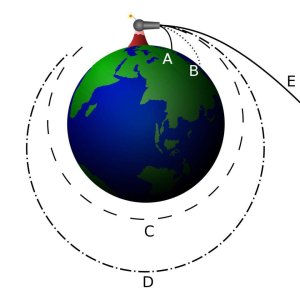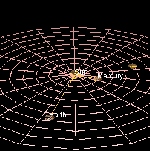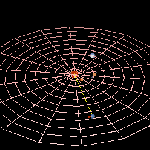
Question: How is the Sun’s gravity strong enough to hold distant planets like Jupiter and Saturn in orbit, but not strong enough to have already swallowed Mercury?
Asked by Shane Borelli
Answer: To understand this, first, you need to know how orbits work. The famous scientist, Sir Isaac Newton thought of a cannon that describes this really well.

Imagine a cannon on top of a very tall mountain. If you fire a cannonball with a normal velocity (A), the cannonball will travel a little and eventually fall back to Earth. If you fire a cannonball with a little more power (B), the ball will travel a little further before coming back to Earth. If you fire a cannonball with enough power, something magical happens; the cannonball is traveling so fast that the Earth literally curves away and the ball never hits the ground (C&D). Finally, if you fire a cannonball with enough power (E), it escapes Earth’s gravity completely.
Continuing to use the Earth as an example, in order for a satellite to maintain a stable orbit, it must fall at the same rate the curve of the Earth falls away from it. This same principle is what keeps the planets in orbit. The closer you are to an object, the faster you need to move to stay in orbit, likewise, the further away you are, the slower you need to move.
Let us use Mercury and Neptune as an example.
—————————————————-

Mercury has an orbital period of about 88 days (meaning, one Mercurian year is equal to about 88 Earth days) and Mercury orbits at a distance of about 0.39 AU (about 60 million km). To maintain this orbit, Mercury must have an orbital velocity (the speed in which it travels around the sun) of about 47.8 km per second.

Neptune, on the other hand, has an orbital period of 164.79 Earth years (or, about 60,000 Earth days – 682 times greater than Mercury’s orbital period, or 682 Mercurian years) and orbits at a distance of about 30 AU (about 4.5 billion km – 75 times greater than Mercury’s). To maintain this orbit, Neptune must have an orbital velocity of 5.43 km per second (which is 11 times slower than Mercury).
—————————————————-
Of course, if Mercury orbited at Neptune’s velocity, it would fall into the Sun, and if Neptune moved as fast as Mercury, it would fly off into interstellar space. Orbital mechanics is a balancing act between your orbital distance and your orbital velocity.